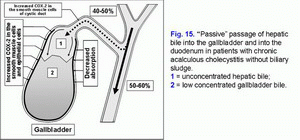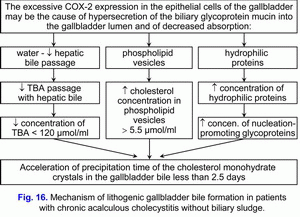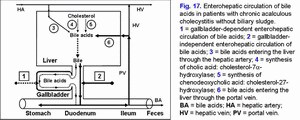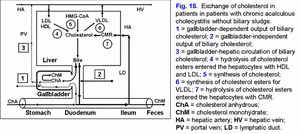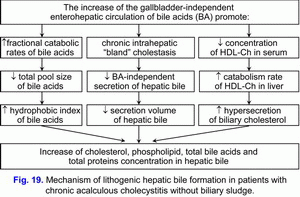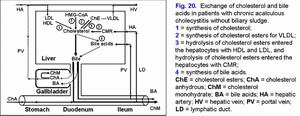
Русский | English
Chronic acalculous cholecystitis without biliary sludge
|
|
Chronic acalculous cholecystitis is an inflammatory disease of gallbladder, associated with chronic inflammation of gallbladder wall and motor dysfunction of the biliary tract, accompanied with biliary pain (1). The cause of the gallbladder motility disorders can be an increased basal cystic duct resistance or cystic duct spasm, the muscle hypertrophy, and the chronic aseptic inflammation in the gallbladder wall.
Diagnostic criteria of the chronic acalculous cholecystitis without biliary sludge
Causes of the gallbladder evacuation dysfunction, biliary pain and chronic inflammation in the gallbladder wall
Mechanism of development of pathologic disordersHigh degree of COX-2 expression in the smooth muscle cells of the gallbladder wall causes the decrease in the evacuation function of the gallbladder and “active” passage of the hepatic bile into the gallbladder (fig. 15). High COX-2 expression in the epithelial cells of the gallbladder mucosa causes decrease of the absorption function of the gallbladder (decrease of water and biliary cholesterol absorption) and “passive” passage of the hepatic bile into the gallbladder (fig. 15). This is accompanied by the decrease in concentration of total bile acids in the gallbladder bile and increase of concentration of biliary cholesterol in gallbladder bile, and causes disturbance in colloidal stability of the gallbladder bile and precipitation of cholesterol monohydrate crystals and calcium bilirubinate granules, i.e. formation of “lithogenic” gallbladder bile (fig. 16). High degree of COX-2 expression in the epithelial cells of the gallbladder mucosa causes hypersecretion of glycoprotein mucin into the gallbladder lumen and gallbladder bile. Increase in the concentration of glycoprotein biliary mucin in the gallbladder bile is accompanied by increase of gallbladder bile viscosity. The decrease in “active” and “passive” passage of the hepatic bile into the gallbladder causes increase of passage of hepatic bile into the duodenum and gallbladder-independent enterohepatic circulation of bile acids, biliary cholesterol and biliary bilirubin (fig. 17). The increase in the gallbladder-independent enterohepatic circulation of bile acids causes increase of concentration of bile acids in the hepatocytes and the decrease in the accumulation function and excretion function of the liver (i.e. formation of chronic “bland” intrahepatic cholestasis) (fig. 17). The increase of the gallbladder-independent enterohepatic circulation of biliary cholesterol helps in increase of absorption of biliary cholesterol in the small intestine, the biliary cholesterol entering hepatocytes and hypersecretion of biliary cholesterol into hepatic bile (fig. 18). These two factors contribute to the formation of the “lithogenic” hepatic bile (fig. 19). The decrease in the gallbladder-dependent output of biliary cholesterol and in the concentration of total bile acids in the gallbladder bile results in formation of the “lithogenic” gallbladder bile and precipitation of the cholesterol monohydrate crystals in the gallbladder lumen in 40% of patients with chronic acalculous cholecystitis without biliary sludge (fig. 20). Surplus COX-2 expression in the epithelial cells of the gallbladder mucosa causes hypersecretion of glycoprotein biliary mucin into the gallbladder bile. Increase in concentration of glycoprotein biliary mucin in gallbladder bile over 2 mg/ml causes its polymerization and formation of sites of the excessive viscosity. Precipitation of cholesterol monohydrate crystals and calcium bilirubinate granules in the sites of the excessive viscosity of polymerized glycoprotein biliary mucin contributes in formation of biliary sludge and transformation of chronic acalculous cholecystitis without biliary sludge into chronic acalculous cholecystitis with biliary sludge. Pathogenetic treatment of patients with chronic acalculous cholecystitis without biliary sludgeAccordingly, treatment of the chronic acalculous cholecystitis without biliary sludge (with biliary pain) aiming for prophylactics of the chronic acalculous cholecystitis with biliary sludge, duodeno-gastral reflux, antral atrophic (bile acid-dependent) gastritis and biliary pancreatitis includes:
Celebrex (Celecoxib) is a selective inhibitor of COX-2. Inhibiting COX-2 activity in the smooth muscle cells of the gallbladder wall and cystic duct results it brings relief of the biliary pain within 3-5 days, restoration of the evacuation function of the gallbladder and the gallbladder-dependent output of biliary cholesterol, “active” and “passive” passage of the hepatic bile into the gallbladder, and decrease in the gallbladder-independent enterohepatic circulation of bile acids, biliary cholesterol and biliary bilirubin. Celebrex (Celecoxib), a selective inhibitor of COX-2, inhibiting COX-2 activity in the epithelial cells of the gallbladder mucosa causes inhibition of glycoprotein mucin hypersecretion into the gallbladder lumen, decrease of concentration of glycoprotein biliary mucin in the gallbladder bile and gallbladder bile viscosity, which prevents formation of biliary sludge. Low COX-2 activity in the epithelial cells of the gallbladder mucosa helps in restoration of the absorption function of the gallbladder (absorption of water and biliary cholesterol), which results in increase in concentration of total bile acids and decrease in concentration of biliary cholesterol in gallbladder bile. Ursofalk (ursodeoxycholic acid), is a hydrophilic hepatoprotective bile acid. It helps in dissolving the cholesterol monohydrate crystals in the gallbladder, decrease in lithogenicity of gallbladder and hepatic bile, disappearance of the chronic “bland” intrahepatic cholestasis (i.e. results in restoration of the accumulation and excretion functions of the liver). Effectiveness is 95%.
Attention!!! Information for patients: Before using this scheme of treatment please check the contraindications (below) and side effects of using pharmacological preparations of Celebrex (Celecoxib) and Ursofalk (ursodeoxycholic acid), and obtain your doctor’s permission. Contraindications for Celebrex (Celecoxib):
Contraindications for Ursofalk (ursodeoxycholic acid):
This web page does not bear any legal responsibility for the use of the proposed treatment schemes without consulting your doctor. References:
|
|
|
